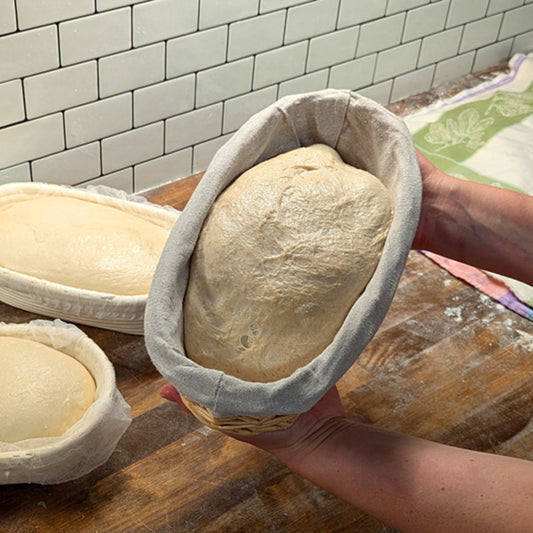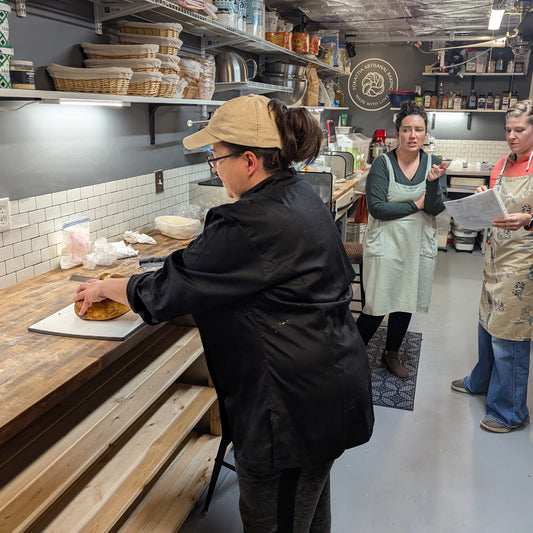Sourdough Starter Maintenance
Maintenance when stored in the fridge:
- Should be done regularly every other weeks.
- In a clean container mix equal amounts of starter, water and flour (30 grams of each). Make sure the flour is well combined with water and starter. After mixing, loosely cover the container to allow breathing (I like to cover it with a cheesecloth with a rubber band).
This type of feeding is called 1:1:1 ratio, or “100% hydration”.
- Wait for 1 hour to give the starter a good chance to get activated.
- Remove 60 grams (two thirds), leaving 30 grams in the container. Close the container with a cover and store in the fridge until the next feeding.
- The 60 grams of starter that you removed can be discarded, or kept for sourdough discard recipes. Discard starter doesn’t need to be fed.

Refreshing before baking
I recommend a 3-feeding approach. It guarantees a very strong and active levain.
The resulting starter that will be used in a particular recipe is called “levain”.
-
First feeding: take your container with the starter from the fridge and add 30 grams of water and 30 grams of all purpose flour, mixing them together. After mixing, keep the resulting starter in a loosely covered container to allow breathing (as mentioned before, I like covering it with a cheesecloth with a rubber band). Make sure your container rests at a place with an ambient temperature and no drafts.
An hour later, move 30 grams of the resulting starter into another container, then store it in the fridge - that’s your fed starter for future bakes (same as maintenance). For the remaining 60 grams, put a rubber band around the container to indicate the level of the starter at the moment, and leave it overnight on a counter.
-
Second feeding: your starter should at least double overnight (compare the level the starter reached to the rubber band). This is an indication of its good health. Next, discard 30 grams, and repeat 1:1:1 feeding with the remaining 30 grams. Cover the container as before, and mark the current level again with rubber. You will now wait until the starter doubles again (3-4 hours) before moving to third feeding.

-
Third feeding: Once the starter is ready, move on to third feeding. Calculate the amount of levain needed for your recipe and use equal amounts of starter, water and flour to reach the target weight (allow for some extra, just in case). Let rest and observe the starter until it activates (“ripens”).
Example 1:
Recipe calls for 55g of levain, you have 90 grams of starter. Use 30g of stater, discard 60g, then mix with 20g of water and 20g of flour. Result: 70g of levain (15g extra).
Example 2:
Recipe calls for 240g of levain, you have 90 grams of starter. Use all your stater (90g), then mix with 100g of water and 100g of flour. Result: 290 g of levain (50g extra).

Signs of active (“ripe”) starter:
- Doubles in size at its peak.
- There are visible bubbles on the top and on the sides.
- Becomes spongy with loosened consistency, very easy to stir.
- Has a pleasantly sour aroma.
Experience baking with our time-honored starter, perfected over decades to create the breads you cherish.
Our live active starter is available for local delivery:
We now offer sourdough classes!
We invite you to attend one of our upcoming workshops at our cozy West Linn bakery.
-
Beginner's Sourdough Workshop by Katya
Vendor:Fokattia Artisanal BakingRegular price $150.00 USDRegular priceUnit price per -
Italian Breads - Sourdough Workshop by Katya
Vendor:Fokattia Artisanal BakingRegular price $150.00 USDRegular priceUnit price per






